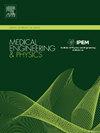Methodology to identify subject-specific dynamic laxity tests to stretch individual parts of knee ligaments
IF 1.7
4区 医学
Q3 ENGINEERING, BIOMEDICAL
引用次数: 0
Abstract
The mechanical properties of ligaments are important for multiple applications and are often estimated from laxity tests. However, the typical laxity tests are not optimized for this application and, a potential exists to develop better laxity tests in this respect. Therefore, the purpose of this study was to develop a methodology to identify optimal, dynamic laxity tests that isolate the stretch of the individual ligaments from each other. To this end, we applied an existing rigid body-based knee model and a dataset of ∼100.000 random samples of applied forces (0–150 N), moments (0–10 Nm) and knee flexion angles (0–90°) through Monte Carlo Simulations. For each modelled ligament bundle, we identified ten load cases; one producing the highest force and nine equally spaced between the maximal and zero force, where the maximal force in all other ligament bundles were minimized. We compared these novel laxity tests to standard internal/external and varus/valgus laxity tests using an isolation metric.
We found that no laxity test could stretch the anterior part of the posterior cruciate and medial cruciate ligaments (PCL and MCL), whereas for all other ligaments, except the posterior PCL, the new laxity tests isolated the ligament stretch 28 % to 450 % better than standard tests.
From our study, we conclude that it is possible to define better laxity tests than currently exist and these may be highly relevant for determination of mechanical properties of ligaments in vivo. Future studies should generalize our results and translate them to modern laxity measurements technologies.
确定针对特定对象的动态松弛测试方法,以拉伸膝关节韧带的各个部位
韧带的机械特性对多种应用都很重要,通常通过松弛测试来估算。然而,典型的松弛测试并没有针对这一应用进行优化,因此有可能在这方面开发出更好的松弛测试。因此,本研究的目的是开发一种方法,以确定最佳的动态松弛测试,从而将单个韧带的拉伸与其他韧带的拉伸隔离开来。为此,我们应用了一个现有的基于刚体的膝关节模型,并通过蒙特卡洛模拟,获得了一个包含 100,000 个随机样本的数据集,这些样本包括外力(0-150 牛)、力矩(0-10 牛)和膝关节屈曲角度(0-90°)。对于每个建模的韧带束,我们确定了十种加载情况:一种是产生最大力的情况,九种是在最大力和零力之间等距加载的情况,其中所有其他韧带束的最大力都被最小化。我们发现,任何松弛测试都无法拉伸后交叉韧带和内侧交叉韧带(PCL 和 MCL)的前部,而对于除后 PCL 外的所有其他韧带,新的松弛测试对韧带拉伸的分离效果比标准测试好 28% 至 450%。从我们的研究中,我们得出结论:有可能定义比现有测试更好的松弛测试,这些测试可能与确定体内韧带的机械性能密切相关。未来的研究应推广我们的结果,并将其转化为现代韧带松弛测量技术。
本文章由计算机程序翻译,如有差异,请以英文原文为准。
求助全文
约1分钟内获得全文
求助全文
来源期刊

Medical Engineering & Physics
工程技术-工程:生物医学
CiteScore
4.30
自引率
4.50%
发文量
172
审稿时长
3.0 months
期刊介绍:
Medical Engineering & Physics provides a forum for the publication of the latest developments in biomedical engineering, and reflects the essential multidisciplinary nature of the subject. The journal publishes in-depth critical reviews, scientific papers and technical notes. Our focus encompasses the application of the basic principles of physics and engineering to the development of medical devices and technology, with the ultimate aim of producing improvements in the quality of health care.Topics covered include biomechanics, biomaterials, mechanobiology, rehabilitation engineering, biomedical signal processing and medical device development. Medical Engineering & Physics aims to keep both engineers and clinicians abreast of the latest applications of technology to health care.
 求助内容:
求助内容: 应助结果提醒方式:
应助结果提醒方式:


